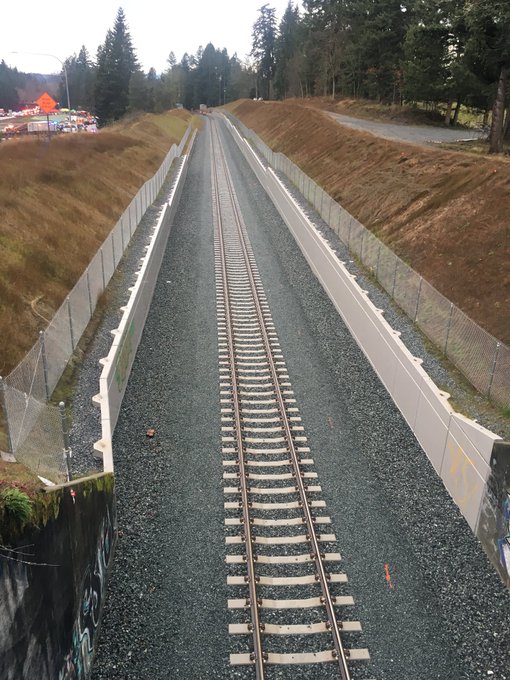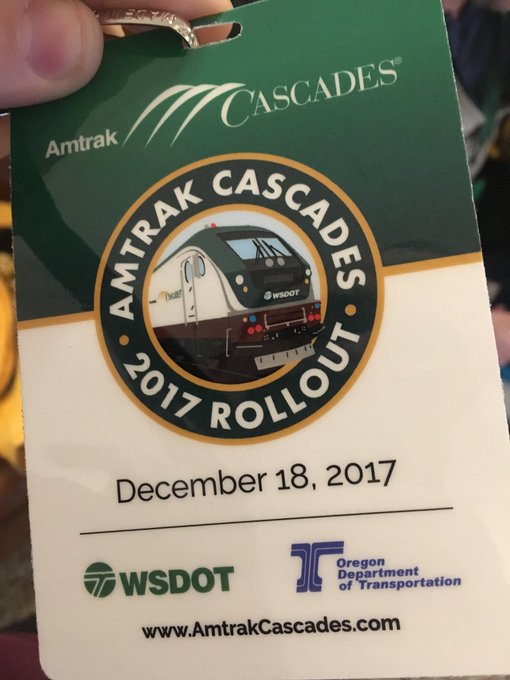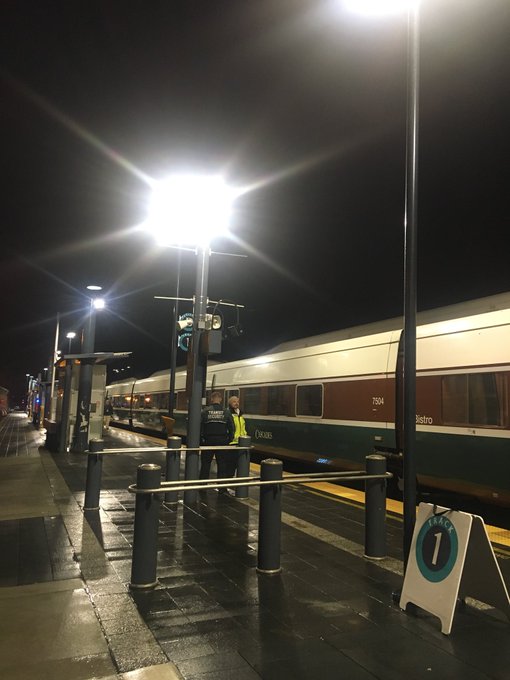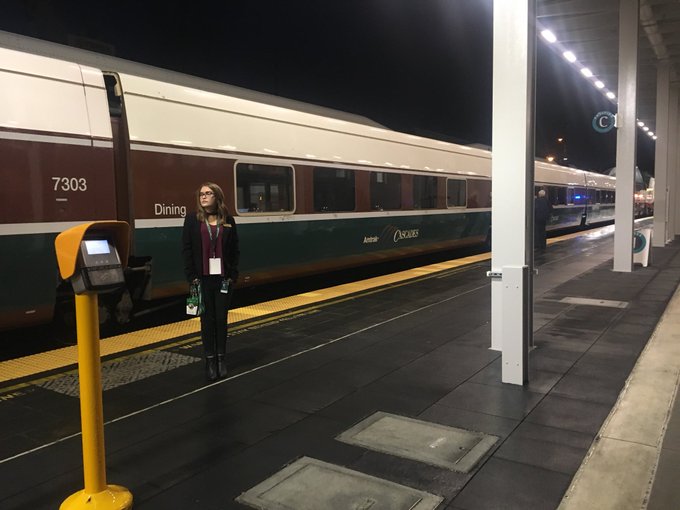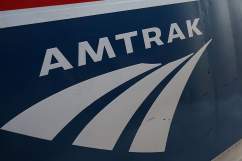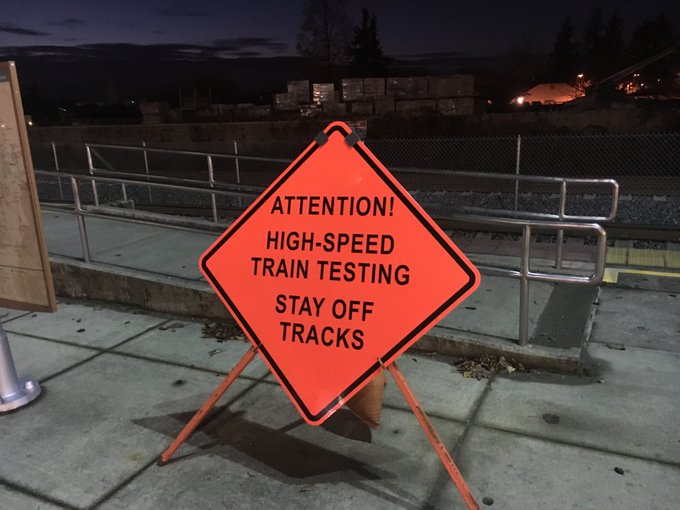
Washington DOT A photo of one of the new Amtrak Cascades locomotives.
The Amtrak Cascades 501 commuter train that derailed Monday morning in DuPpont, Washington, was the first run of a new line that was created to save time and create more reliable, faster and more frequent service between Seattle and Portland.
The Washington Department of Transportation oversaw the $800 million Cascades High-Speed Rail Capital Program, including the Point Defiance Bypass that changed the path of the commuter trains in the Tacoma area, where the derailment occurred.
“All trains on the route will be around 20 minutes faster than today. Most of time savings come from a new route that bypasses Point Defiance in Tacoma. That section of track, while scenic, forces trains to slow down and has been the site of many mudslides that close the line for 48 hours,” KING-TV’s Ricky Courtney reported in August. “The Point Defiance Bypass is just one of 20 infrastructure projects along the corridor funded by nearly $800 million in federal high-speed rail grants. Despite that name, the current 79 MPH speed limit on the route won’t be increasing.”
The cause of Monday’s derailment is still unknown. The Pierce County Sheriff’s Office has said that there were fatalities and injuries, but the number of the dead and wounded was not immediately available. You can follow updates on the derailment here.
Here’s what you need to know about the project:
1. The Project Included $180.7 Million to Create the ‘Point Defiance Bypass’ Where the Derailment Occurred
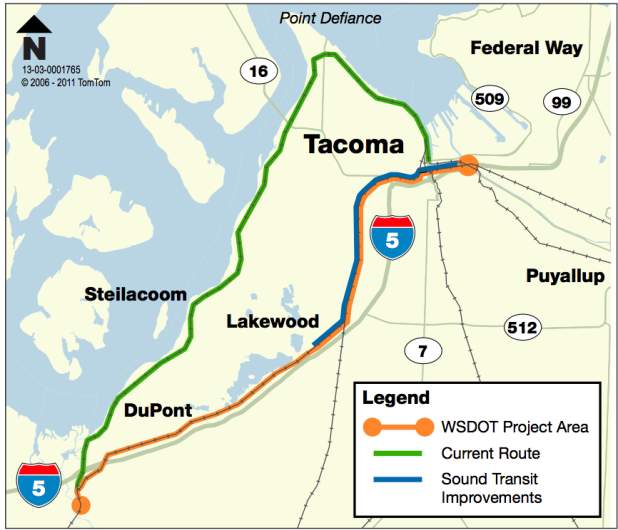
Washington DOT
The $800 million project included $180.7 million to create the “Point Defiance Bypass,” which included the new Amtrak Cascades route where the train derailed Monday.
“The Point Defiance Bypass Project will reroute passenger trains to an inland rail line along the west side of I-5 through south Tacoma, Lakewood, and DuPont. Sound Transit currently uses a portion of this route for Sounder commuter rail service to Lakewood,” the Washington DOT said in a press release. “This project will improve passenger train reliability by reducing congestion with freight trains and eliminating travel on tight corners and tunnels.”
The project began in 2011, with environmental testing, while construction began in 2015 and was completed in Spring 2017. According to a DOT handout, construction included 14.5 miles of “new and upgraded track,” including through Lakewood and DuPont, where the derailment occurred.
“The improvements will allow passenger trains to use the bypass route without being delayed by freight or Sounder trains. After the completion of other capital rail projects, two additional daily round trip passenger trains could be added. Freight train traffic will not increase on this line beyond the minimal amount that utilizes it today,” the DOT said. “When completed, the Point Defiance Rail Bypass project will bring a total of six daily round trip Amtrak Cascades trains and one Coast Starlight train through Tacoma, Lakewood, and DuPont intersections, with an average crossing time of 45 seconds per intersection and a maximum speed of 79 mph.”
The Washington DOT said in a statement, “The Amtrak Cascades train service is jointly owned by the Washington State Department of Transportation and the Oregon Department of Transportation. Amtrak operates the service for the two states as a contractor, and is responsible for day to day operations. Amtrak Cascades runs trains from Vancouver, British Columbia, to Eugene, Oregon.
“The tracks, known as the Point Defiance Bypass, are owned by Sound Transit. The tracks were previously owned by BNSF and were used for occasional freight and military transport. WSDOT received federal grants to improve the tracks for passenger rail service. As owners of the corridor Sound Transit managed the track upgrade work under an agreement with WSDOT. Funding for the upgrades was provided by the Federal Railroad Administration, which reviewed work throughout the duration of the contract. Today was the first day of public use of the tracks, after weeks of inspection and testing,” the DOT said.
CNN reported on the track improvements project in 2013, calling it a “high-speed rail boondoggle” because the plan only saved 10 minutes of travel time between Portland and Seattle, and was billed as something it wasn’t, truly high speed.
2. The Washington DOT Was Celebrating the Inaugural Run of the New Route Before the Derailment
The Washington DOT was celebrating the inaugural run of the new trains before the derailment. The debut of the new train line was highly anticipated. Local news crews were covering the departure of the first train.
“People can get where they’re going sooner, with more schedule choices and better reliability,” said Ron Pate, WSDOT Rail, Freight and Ports Division director, in a press release in October. According to the Washington DOT:
This permanent change to the Amtrak Cascades schedule means travel time between the two cities will be reduced by 10 minutes to 3 hours and 20 minutes, thanks to the rerouting of trains between Tacoma and Olympia and the upgrading of tracks and signal systems. The new route takes trains on an inland corridor parallel to Interstate 5 through Tacoma, Lakewood, Joint Base Lewis-McChord, and DuPont. It eliminates a major chokepoint for passenger trains near Point Defiance in Tacoma and separates them from freight trains that will continue to use the old waterfront route. The results are shorter travel times and greater on-time reliability.
The DOT invested $800 million in the project.
“WSDOT worked closely with many partners over the last six years to prepare for these new schedules. Dec. 18 marks a major milestone for passenger rail service in the Pacific Northwest,” Pate said. “While the scenic beauty of the Point Defiance route can’t be denied, we know passengers will appreciate the ability to make easier, and more reliable, day trips between Seattle and Portland. Spectacular water views are still available for passengers between Seattle and Vancouver, British Columbia.”
The DOT said the trains would be pulled by new Charger locomotives, leaving both Portland and Seattle every two to three hours. The first trains left Seattle at 6 a.m. and Portland at 6:20 a.m.
Alex Rozier, a reporter with KING-TV in Seattle was on the first train to leave on the new route, but got off before the crash, he said on Twitter. The DOT was handing out landyards to passengers to commemorate the launch.
Chris Karnes, the chairman of Pierce Transit’s advisory board, was tweeting live from the train before the derailment. He wrote, “Wow this train is fast. Once you leave Downtown Tacoma it’s 79mph to Portland. We are passing up traffic on I-5.”
“Tacoma to Dupont in roughly 15 minutes,” he said.
He then said, the train had derailed.
The cause of the derailment is not yet known.
3. The New Trains Were Expected to Have Positive Train Control, but It Wasn’t in Place
The new route improvement also included new locomotives and a positive train control system, which aims to help prevent crashes, according to a Washington DOT press release. Officials have not said if the positive train control system was in place.
According to the press release, “This ‘next generation’ rail equipment features safety upgrades, including on-board positive train control system, which will automatically stop the train when there are dangerous situations on the rails, once the system is activated corridor-wide in 2018.”
But Amtrak President Richard Anderson told reporters that positive train control was not activated at the time of the derailment.
The DOT purchased “8 new state-of-the-art Siemens Charger locomotives” to pull the Amtrak Cascades trains.
“The new 4,400-horse power Cummins QSK95 engines are 42,000 pounds 8-foot tall and meet new, stringent emission standards. The new locomotives were delivered in summer 2017 and, after testing and training, started running on the Amtrak Cascades corridor in November 2017,” the DOT said. “Faster acceleration allows for trains to move along the corridor more efficiently, as well as more easily passing slower freight trains and other sidings. Adding a smoother, more efficient train ride also provides more multimodal options for travelers.The new locomotives are also more reliable, requiring less maintenance and upkeep and less downtime. The locomotives meet the strictest Environmental Protection Agency Tier IV emissions standards and are lighter and quieter.”
4. Tests Had Been Run on the New Line for Several Months
The DOT had been running tests on the new route for several months and were providing warnings to local residents about the changes.
“We want to make sure as many people as possible understand what’s going on, understand we are starting a new service on December 18th and ensure that they know how to stay safe around the railroad tracks,” Janet Matkin, of the WSDOT, told KOMO-TV in early December.
Others, like Joint Base Lewis-McCord, had been putting out public services notices in recent days to alert locals about the new service.
The DOT also enlisted Seattle Seahawks wide receiver Doug Baldwin to create safety messages.
Testing has been ongoing since February and March.
“We’re trying to raise awareness that people will be seeing more trains, and many traveling at faster than usual speeds, in the area,” Rachelle Cunningham, a spokeswoman for Sound Transit, told The News Tribune.
“During the testing, the fast-moving trains will come from either direction, both day and night, with the exception of peak commute times,” the DOT said in a press release. “Because these tracks previously were used by slower freight trains, residents should be prepared for the more frequent and faster trains.”
5. A Local Mayor Warned That Someone Might be Killed Because of the New Line Just Weeks Before the Derailment
At a December 5 city meeting, Mayor Don Anderson told Washington Department of Transportation officials that he believed it would be just a matter of time before the high-speed trains kill someone, according to KOMO-TV. He said he believed the trains are too close to cars and pedestrians. Anderson was concerned that there were not grade separations along some parts of the line to keep the trains away from cars. The cause of Monday’s derailment is not yet known.
“Come back when there is that accident, and try to justify not putting in those safety enhancements, or you can go back now and advocate for the money to do it, because this project was never needed and endangers our citizens,” Anderson said at the meeting.
Anderson could not be immediately reached by Heavy for comment on his reaction to the derailment. But he told MSNBC, “Our community has been very concerned about the safety of this modification of the rail route for several years and were unsuccessful in either stopping it or having some modifications.”
Lakewood is located about 20 minutes north of Dupont, where the derailment occurred.
